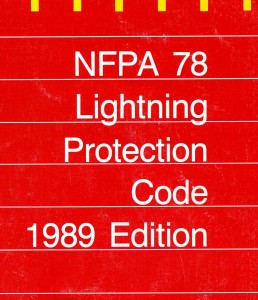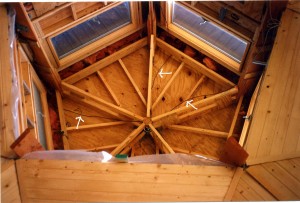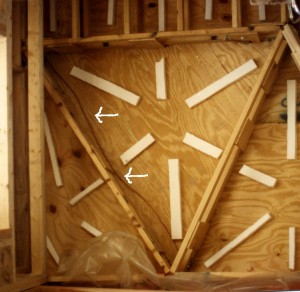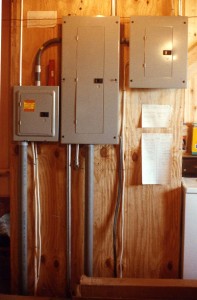Protecting Domehenge: When Lightning Strikes!
 As we were spending our first night in a tent on the top of Backbone Mountain, say about summer of 1992, it came to pass that we had a small thunderstorm. The rain whipped about and the lightning flashed and with each crash I began to wonder if this was a good place to put up a tower with antennas or to even build a house. Later, back in Crystal City I researched the subject and finally came upon bulletin number 78 of the National Fire Protection Association (NFPA). Here was the golden truth. NFPA-78 (now NFPA 780) is totally devoted to the protection of buildings, towers and other constructions from lightning. And, the research has been blessed by the insurance industry, which have the greatest interest in good construction.
As we were spending our first night in a tent on the top of Backbone Mountain, say about summer of 1992, it came to pass that we had a small thunderstorm. The rain whipped about and the lightning flashed and with each crash I began to wonder if this was a good place to put up a tower with antennas or to even build a house. Later, back in Crystal City I researched the subject and finally came upon bulletin number 78 of the National Fire Protection Association (NFPA). Here was the golden truth. NFPA-78 (now NFPA 780) is totally devoted to the protection of buildings, towers and other constructions from lightning. And, the research has been blessed by the insurance industry, which have the greatest interest in good construction.
I decided that the best time to install a lightning protection system would be before the electrical wiring was put in. After all, a house full of #12 copper wire would attract lightning just like a lightning rod. So, the installation of a good lightning protection system had to precede the electric wiring of the house.
The first subject was “Ground”. Well, that seems proper as we all imagine the lightning bolt coming down from the clouds and looking for a path to the earth. So, on my next trip to the mountain I took 6 ft ground rods and a hammer and my volt/ohmmeter. I would measure the resistance between the ground rods. NFPA 78 gave me typical values.
The first rod went into the ground about 2 feet and then decided it wanted to be a bell not a ground. Each time I hit it, it rang with a beautiful tone but refused to go another inch deeper. The second rod went in about 6 inches and then turned up and went the rest of the way parallel to the surface. The measured resistance between the rods was over 600 ohms. Clearly I had discovered the famous Glass Mountain.
I was building on a giant, leaky insulator!
NFPA-78 has a solution for grounding structures where there is no or poor electrical ground conductivity. It is called a counterpoise, a sort of fake ground. Actually it is good to think of the counterpoise as one plate of a large capacitor, the earth being the other plate. I had a trench dug all around the house and buried a heavy copper cable three to four ft. down and 1 or 2 feet away from the foundation of the house. Then, I planned for all the ground wires from the lightning arrester to come down from the roof directly to this underground loop. All the wires were #2 stranded cable, a cable about 1/4 inch diameter. Three brass split bolt connectors were used at every splice. And in some places where the wire would be unsightly I replaced it with a strip of sheet copper.
Following NFPA-78 to the letter, I tied all metal structures in the house to the downleads going to the counterpoise. Window frames, water pipes, the heating system, the water conditioner, and the well pump, everything metal was grounded to prevent sideways flashover. Lastly, I made a major decision to wire the house electric system in steel pipes called EMT which were also grounded to the counterpoise. All led up to a single lightning rod on the top point of the dome cupola. The lightning rod was actually a 6 foot grounding rod turned upside down.
So, the day finally came when all the lightning protection was installed but the interior panels were not yet installed, and one could see the bare cables running down all sides of the house just inside the bare outer sheathing. The workmen were all on the roof putting on the top shingling when one called down to me that he saw some lightning flashes on the hills to our west. I made all of them get off the roof and we sat on the bare second floor waiting for the storm to pass. Grumble, grumble, grumble!!!
Suddenly there was a loud explosion as the next bolt of lightning hit the house!
Eyes bugged out and we all paled. I realized that those bare copper wires that we had just installed had carried the full current (some 10,000 amps) of that lightning stroke to my counterpoise ground. We recovered and I had everyone go through the house looking for any fire or smoke or any other problems and we found nothing. But the workmen reported later that the tip of the lightning rod appeared to be burned off.
Since that initial event the house has been hit two more times. The second hit was in the middle of the night and there was no visible damage. Both of the first two were before the antenna towers had been put up. The third strike was just a few months ago. This time I did suffer some minor losses. There was again no damage, or fire, to the house.
But, the main power transformer serving the house from the 7200 volt line, about 50 ft from the house, was completely destroyed.
The electric company came and replaced the transformer that afternoon. The telephone company came soon thereafter and replaced the telephone interface, which is contained in an adjacent cabinet to the electric.
With power on, now other little losses began to reveal themselves. The well pump was in good condition but the pump controller in the utility room was fried. Also the hot water heater blew a small fuse. This caused some confusion to the repairmen as the fuse was shown on the circuit diagram, but we could not find it on the controller panel. Finally found it buried deep inside the cabinet.
The Ham Station came through almost without any failures. But closer testing revealed that the antenna rotator could only move at full speed. Further testing revealed that the rotator controller in the ham station had failed. Thank goodness we did not have to take the tower down to repair the rotator motor.
What conclusions have I come to after these experiences? Here are some of them.
- YES!! Put in the main parts of your lightning system BEFORE any electric wiring or metal pipes are installed.
- Follow NFPA-780 to the absolute letter.
- Lightning is capricious. If you put up a steel tower here — it may hit your house some twenty feet over there. But if you follow the book, well, then there is a much lower chance that it will get into your kitchen and blow up the coffee pot! Heavens, there are some things we absolutely must protect!
Did you enjoy this post? Why not leave a comment below and continue the conversation, or subscribe to my feed and get articles like this delivered automatically to your feed reader.





[…] lightning protection is a natural for the dome. (See my post here) A single lightning rod on the top center of the dome splits and leads down each roof strut to […]